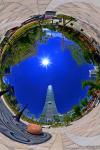
TLS Booster (NSRRC)
Hsinchu Science Park, Hsinchu, Taiwan
September 21, 2005 - 02:15 UTC (10:15 TPE)
© 2005 Walker Young, All Rights Reserved.
The TLS located at the National Synchrotron Radiation Research Center (NSRRC), is used in experiments involving new optics and optical devices.
A normal battery is able to accelerate an electron to a kinetic energy of 1.5 electron volts. This energy can make the electron fly with the speed of 700 kilometers per second. The battery itself composes a basic part of so called accelerator.
Since 1890's, the scientists had used billions of accelerator to contribute the modern civilization of human being. Just for a few examples, the accelerators facilitated the discovery X-ray, electron as well as thousands of other physical particles, and the accelerators also are the key componets of television sets, microwave ovens and fluorescent lamps. In all accelerators, a huge amount of energy was transferred to the kinetic energy of electric particles.
The synchrotron type is the most powerful and efficient accelerator of all. In 1947, the scientists discovered that, as the electrons circle the ring of synchrotron, they give off light , which is called synchrotron radiation.
The machine of synchrotron radiation soon became a remarkable tool of scientific and industrial research. It plays the role of modern life as telescope had been playing over last three centries. In this panoroma, an accelerator called booster is shown. This booster can accelerate electron beam to 1.5 billion vlots. This electron beam is to be feed in a storage ring and to generate synchrotron light in the range from infra-red to soft X-ray.
by NSRRC Tc Fan


 Tap or click the zoom icon in the bottom right corner of the picture to switch between in-page and fullscreen view
Tap or click the zoom icon in the bottom right corner of the picture to switch between in-page and fullscreen view